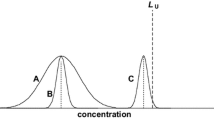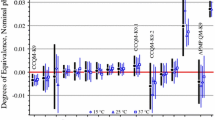Abstract
Classical measurements of performances are typically based on linear scales. However, in analytical chemistry one scale may be not sufficient to measure items appropriately. However, explorative statistics provide more factors, which all tell their own story about the analytical performance. Partial order methodology offers a possibility to evaluate analytical performance based on data provided, e.g., through method development and thus method optimization. Without presumptions or pretreatment of the data, the performance can be evaluated taking into account all indicators simultaneously and thus elucidating a “distance” from a reference, i.e., a result that is considered as the “best” or “optimal” possibly based on a certified value. In the present study, we elucidate the mutual ranking of the single analytical approaches, i.e., results from different analytical procedures. Initially, a simple approach for evaluating analytical performance is presented followed by more elaborate analyses. The analyses are based on various partial order tools and lead to (1) a partial ordering of the different analytical approaches (2) the “distance” to the reference value and (3) a classification due to the concept of “peculiar points” pin-pointing certain methods that do not fall into the “main-stream”. Additionally, information on the relative importance of the single indicator for the overall performance and a ranking without assuming weights for any single indicator can be obtained. In multi-rule systems incomparabilities appear, i.e., not every analytical result can be compared with another one. Even minor differences in indicator values may lead to incomparabilities. To elucidate these factors a detailed study of incomparabilities based on scanning analyses, tripartite graphs and fuzzy partial orders are presented in order to better understand strengths and weaknesses of the different analytical approaches. Thus, the analyses may lead to detailed recommendations for subsequent improvement. Eventually, the possible use of weight intervals for the single indicators is discussed.
Access this chapter
Tax calculation will be finalised at checkout
Purchases are for personal use only
Similar content being viewed by others
References
ASTM (2013) Standard practice for verification and use of control charts in spectrochemical analysis, ASTM E1329-10. ASTM International, West Conshohocken, PA
Brans JP, Vincke PH, Mareschal B (1986) How to select and how to rank projects: the PROMETHEE method. Eur J Oper Res 24:228–238
Bruggemann R, Annoni P (2014) Average heights in partially ordered sets. MATCH Commun Math Comput Chem 71:117–142
Bruggemann R, Carlsen L (eds) (2006a) Partial order in environmental sciences and chemistry. Springer, Berlin
Bruggemann R, Carlsen L (2006b) Introduction to partial order theory exemplified by the evaluation of sampling sites. In: Bruggemann R, Carlsen L (eds) Partial order in environmental sciences and chemistry. Springer, Berlin, pp 61–110
Bruggemann R, Carlsen L (2011) An improved estimation of averaged ranks of partially orders. MATCH Commun Math Comput Chem 65:383–414
Bruggemann R, Carlsen L (2012) Multi-criteria decision analyses. Viewing MCDA in terms of both process and aggregation methods: some thoughts, motivated by the paper of Huang, Keisler and Linkov. Sci Total Environ 425:293–295
Bruggemann R, Carlsen L (2014) Incomparable - what now? MATCH Commun Math Comput Chem 71:694–716
Bruggemann R, Carlsen L (2015) Incomparable ‐ what now, III. Incomparabilities, elucidated by a simple version of ELECTRE III and a fuzzy, partial order approach. MATCH Commun Math Comput Chem 73:277–302
Bruggemann R, Münzer B (1993) A graph-theoretical tool for priority setting of chemicals. Chemosphere 27:1729–1736
Bruggemann R, Patil GP (2011) Ranking and prioritization for multi-indicator systems – introduction. Springer, New York
Bruggemann R, Voigt K (1995) An evaluation of online databases by methods of lattice theory. Chemosphere 31:3585–3594
Bruggemann R, Voigt K (2008) Basic principles of Hasse diagram technique in chemistry. Comb Chem High Throughput Screen 11:756–769
Bruggemann R, Voigt K (2011) A new tool to analyze partially ordered sets - application: ranking of polychlorinated biphenyls and alkanes/alkenes in River main, Germany. MATCH Commun Math Comput Chem 66:231–251
Bruggemann R, Sørensen PB, Lerche D, Carlsen L (2004) Estimation of averaged ranks by a local partial order model. J Chem Inf Comput Sci 44:618–625
Bruggemann R, Kerber A, Restrepo G (2011) Ranking objects using fuzzy orders, with an application to refrigerants. MATCH Commun Math Comput Chem 66:581–603
Bruggemann R, Restrepo G, Voigt K, Annoni P (2013) Weighting intervals and ranking. Exemplified by leaching potential of pesticides. MATCH Commun Math Comput Chem 69:413–432
Bruggemann R, Carlsen L, Voigt K, Wieland R (2014) PyHasse software for partial order analysis. In: Bruggemann R, Carlsen L, Wittmann J (eds) Multi-indicator systems and modelling in partial order. Springer, New York, pp 389–423
Carlsen L, Bruggemann R (2008) Accumulating partial order ranking. Environ Model Softw 23:986–993
Carlsen L, Bruggemann R, Kenessova O, Erzhigitov E (2015) Evaluation of analytical performance based on partial order methodology. Talanta 132:285–293
Colorni A, Paruccini M, Roy B (2001) A-MCD-A, Aide Multi Critere a la Decision, multiple criteria decision aiding. JRC European Commission, Ispra
De Loof K, De Meyer H, De Baets B (2006) Exploiting the lattice of ideals representation of a poset. Fundam Inform 71:309–321
Ernesti J, Kaiser P (2008) Python - Das umfassende Handbuch. Galileo Press, Bonn
Figueira J, Greco S, Ehrgott M (2005) Multiple criteria decision analysis, state of the art surveys. Springer, Boston
Gomes LFAM, Rangel LAD (2009) An application of the TODIM method to the multicriteria rental evaluation of residential properties. Eur J Oper Res 193:204–211
Hajkowicz S, Higgins A (2008) A comparison of multiple criteria analysis techniques for water resource management. Eur J Oper Res 184(2008):255–265
Hetland ML (2005) Beginning Python - from Novice to professional. Apress, Berkeley
JCGM 200 (2008) International vocabulary of metrology — basic and general concepts and associated terms (VIM). http://www.bipm.org/utils/common/documents/jcgm/JCGM_200_2008.pdf. Accessed Jan 2015
Kosko B (1992) Neural networks and fuzzy systems ‐ a dynamical systems approach to machine learning. Pentice Hall, London
Kruse R, Moewes C (2015) Fuzzy systems, Fuzzy set theory., http://fuzzy.cs.uni-magdeburg.de/ci/fs/fs_ch02_fst.pdf. Accessed Jan 2015
Lærd (2013) Standard score. https://statistics.laerd.com/statistical-guides/standard-score.php. Accessed Jan 2015
Langtangen HP (2008) Python scripting for computational science. Springer, Berlin
Lerche D, Sørensen PB, Bruggemann B (2003) Improved estimation of the ranking probabilities in partial orders using random linear extensions by approximation of the mutual ranking probability. J Chem Inf Comput Sci 43:1471–1480
Morton J, Pachter L, Shiu A, Sturmfels B, Wienand O (2009) Convex rank tests and semigraphoids. SIAM J Discrete Math 23:1117–1134
Munda G (2008) Social multi-criteria evaluation for a sustainable economy. Springer, Heidelberg
Python (2015) Python. https://www.python.org/. Assessed Jan 2015
R Core Team (2015) R: a language and environment for statistical computing. R Foundation for Statistical Computing, Vienna, Austria, http://www.R-project.org/. Accessed Jan 2015. ISBN 3-900051-07-0
Roy B (1972) Electre III: Un Algorithme de Classements fonde sur une representation floue des Preferences En Presence de Criteres Multiples. Cahiers du Centre d’Etudes de Recherche Operationelle 20:32–43
Roy B (1980) Selektieren, Sortieren und Ordnen mit Hilfe von Prävalenzrelationen: Neue Ansätze auf dem Gebiet der Entscheidungshilfe für Multikriteria-Probleme. zfbf-Schmalenbachs Zeitschrift für betriebswirtschaftliche Forschung 32:465–497
Roy B (1990) The outranking approach and the foundations of the ELECTRE methods. In: Bana e Costa CD (ed) Readings in multiple criteria decision aid. Springer, Berlin, pp 155–183
Roy B, Bouyssou D (1986) Comparison of two decision-aid models applied to a nuclear power plant siting example. Eur J Oper Res 25:200–215
Stone DC, Ellis J (2009) Aim of statistics in analytical chemistry. Department of Chemistry, University of Toronto. http://www.chem.utoronto.ca/coursenotes/analsci/stats/AimStats.html. Accessed Jan 2015
Taylor C (2013) What is Skewness. http://statistics.about.com/od/Descriptive-Statistics/a/What-Is-Skewness.htm. Accessed Jan 2015
Van de Walle B, De Baets B, Kersebaum KC (1995) Fuzzy multi‐criteria analysis of cutting techniques in a nuclear dismantling project. Fuzzy Sets Syst 74:115–126
Weigend M (2006) Objektorientierte Programmierung mit Python. Mitp, Bonn
Wienand O (2006) lcell. http://bio.math.berkeley.edu/ranktests/lcell/. Accessed Jan 2015
Author information
Authors and Affiliations
Corresponding author
Editor information
Editors and Affiliations
Rights and permissions
Copyright information
© 2017 Springer International Publishing AG
About this chapter
Cite this chapter
Carlsen, L., Bruggemann, R. (2017). Partial Ordering and Metrology Analyzing Analytical Performance. In: Fattore, M., Bruggemann, R. (eds) Partial Order Concepts in Applied Sciences. Springer, Cham. https://doi.org/10.1007/978-3-319-45421-4_4
Download citation
DOI: https://doi.org/10.1007/978-3-319-45421-4_4
Published:
Publisher Name: Springer, Cham
Print ISBN: 978-3-319-45419-1
Online ISBN: 978-3-319-45421-4
eBook Packages: Earth and Environmental ScienceEarth and Environmental Science (R0)




